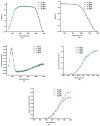Raytracing Modelling of Infrared Light Management Using Molybdenum Disulfide (MoS2) as a Back-Reflector Layer in a Silicon Heterojunction Solar Cell (SHJ)
- PMID: 35888490
- PMCID: PMC9321389
- DOI: 10.3390/ma15145024
Raytracing Modelling of Infrared Light Management Using Molybdenum Disulfide (MoS2) as a Back-Reflector Layer in a Silicon Heterojunction Solar Cell (SHJ)
Abstract
The silicon heterojunction solar cell (SHJ) is considered the dominant state-of-the-art silicon solar cell technology due to its excellent passivation quality and high efficiency. However, SHJ's light management performance is limited by its narrow optical absorption in long-wave near-infrared (NIR) due to the front, and back tin-doped indium oxide (ITO) layer's free carrier absorption and reflection losses. Despite the light-trapping efficiency (LTE) schemes adopted by SHJ in terms of back surface texturing, the previous investigations highlighted the ITO layer as a reason for an essential long-wavelength light loss mechanism in SHJ solar cells. In this study, we propose the use of Molybdenum disulfide (MoS2) as a way of improving back-reflection in SHJ. The text presents simulations of the optical response in the backside of the SHJ applying the Monte-Carlo raytracing method with a web-based Sunsolve high-precision raytracing tool. The solar cells' electrical parameters were also resolved using the standard electrical equivalent circuit model provided by Sunsolve. The proposed structure geometry slightly improved the SHJ cell optical current density by ~0.37% (rel.), and hence efficiency (η) by about 0.4% (rel.). The SHJ cell efficiency improved by 21.68% after applying thinner back ITO of about 30 nm overlayed on ~1 nm MoS2. The efficiency improvement following the application of MoS2 is tentatively attributed to the increased NIR absorption in the silicon bulk due to the light constructive interface with the backside components, namely silver (Ag) and ITO. Study outcomes showed that improved SHJ efficiency could be further optimized by addressing front cell components, mainly front ITO and MoS2 contact engineering.
Keywords: computer simulations; dimensionality reduction; light trapping; photovoltaic cells; raytracing; thin films.
Conflict of interest statement
The authors declare no conflict of interest.
Figures








References
-
- VDMA ITRPV Results 2021. [(accessed on 14 July 2021)]. Available online: https://itrpv.vdma.org/documents/27094228/29066965/Readiness0ITRPV02020/....
-
- Elsmani M.I., Fatima N., Jallorina M.P.A., Sepeai S., Su’ait M.S., Ludin N.A., Teridi M.A.M., Sopian K., Ibrahim M.A. Recent Issues and Configuration Factors in Perovskite-Silicon Tandem Solar Cells towards Large Scaling Production. Nanomaterials. 2021;11:3186. doi: 10.3390/nano11123186. - DOI - PMC - PubMed
-
- Green M.A., Dunlop E.D., Hohl-Ebinger J., Yoshita M., Kopidakis N., Hao X. Solar cell efficiency tables (Version 58) Prog. Photovolt. Res. Appl. 2021;29:657–667. doi: 10.1002/pip.3444. - DOI
-
- Green M.A., Dunlop E.D., Hohl-Ebinger J., Yoshita M., Kopidakis N., Hao X. Solar cell efficiency tables (version 59) Prog. Photovolt. Res. Appl. 2022;30:3–12. doi: 10.1002/pip.3506. - DOI
-
- Nasir N.S.M., Sepeai S., Leong C.S., Sopian K., Zaidi S.H. Infra-red investigation on silicon solar cells. Malays. J. Anal. Sci. 2017;21:1134–1142. doi: 10.17576/mjas-2017-2105-16. - DOI
Grants and funding
LinkOut - more resources
Full Text Sources
Miscellaneous

